The concrete epoxy repair market is likely to grow from USD 2.2 million in 2025 to USD 3.3 million in 2035, recording a CAGR of 4.3%. The market share dynamics reflect a gradual gain for manufacturers offering high-performance, fast-curing, and environmentally safer formulations. The competitive landscape is witnessing consolidation as regional suppliers expand their distribution reach and global brands invest in product innovation to strengthen their foothold.
Between 2025 and 2030, share gains are expected among producers emphasizing advanced epoxy systems capable of withstanding thermal stress and heavy mechanical loads. Infrastructure rehabilitation projects and industrial flooring repair are major contributors to this phase of expansion. By 2035, growth will likely be supported by government initiatives promoting maintenance and safety compliance in construction. Market leaders are anticipated to retain their dominance through strategic alliances, improved formulations, and service differentiation.
Smaller players focusing on niche applications such as marine structures or high-moisture environments may experience marginal share improvement through specialized offerings. The competition from low-cost alternatives and fluctuations in raw material prices could marginally erode profitability in certain segments. The market indicates more share gain than erosion, driven by innovation, increased restoration activities, and rising demand for durable repair solutions.
Research and development operations demonstrate coordination challenges between materials scientists developing enhanced formulation performance and regulatory specialists managing product registration processes across multiple markets. Innovation cycles extend when new formulations require extensive testing for both technical performance validation and regulatory compliance verification, affecting competitive positioning in markets where rapid infrastructure deterioration demands immediate repair solutions.
Competitive dynamics intensify when companies navigate between cost optimization pressures and compliance overhead costs that affect pricing strategies. Smaller regional suppliers struggle with regulatory compliance costs while competing against larger manufacturers with dedicated regulatory affairs departments, creating market consolidation pressures that affect product availability and pricing in specific geographic regions.
Quality assurance protocols demand coordination between technical testing laboratories validating structural performance characteristics and analytical laboratories ensuring chemical composition compliance with evolving regulatory standards. Product certification processes require ongoing monitoring of regulatory changes across multiple jurisdictions, affecting product formulation strategies and market entry decisions for companies serving diverse geographic markets.
Customer relationship management creates tensions between technical sales teams promoting product capabilities and compliance departments ensuring proper customer education regarding handling, application, and disposal requirements. Construction clients demand rapid project completion while navigating increasingly complex documentation requirements for chemical usage reporting, waste disposal certification, and worker safety compliance that vary across different project locations and regulatory jurisdictions.
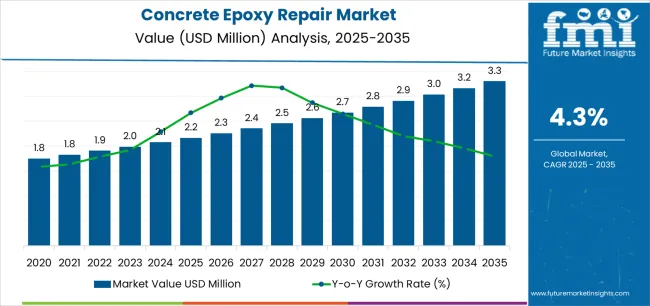
| Period | Primary Revenue Buckets | Share | Notes |
|---|---|---|---|
| Today | Manual application systems (construction, infrastructure) | 72% | Traditional repair methods, established applications |
| Injection method applications | 28% | Precision repairs, specialized applications | |
| Future (3-5 yrs) | Advanced injection systems | 58-62% | Automated application, engineered solutions |
| Infrastructure maintenance | 18-22% | Bridge repairs, highway maintenance | |
| Industrial facility repairs | 12-16% | Manufacturing plants, chemical facilities | |
| Residential & commercial | 8-12% | Building maintenance, concrete restoration | |
| Specialized applications | 6-10% | Marine structures, underground repairs | |
| Technical services | 3-6% | Installation support, maintenance programs |
At-a-Glance Metrics
| Metric | Value |
|---|---|
| Market Value (2025) | USD 2.2 million |
| Market Forecast (2035) | USD 3.3 million |
| Growth Rate | 4.3% CAGR |
| Leading Technology | Injection Method Systems |
| Primary Application | Construction Industry |
The market demonstrates strong fundamentals with injection method systems capturing a dominant share through advanced repair properties and construction application optimization. Construction industry applications drive primary demand, supported by increasing infrastructure maintenance requirements and construction industry modernization initiatives. Geographic expansion remains concentrated in developed markets with established construction infrastructure, while emerging economies show accelerating adoption rates driven by infrastructure development initiatives and rising construction standards.
Design for construction scalability, not just performance
Primary Classification: The market segments by method into manual application and injection method, representing the evolution from traditional repair techniques to sophisticated precision application systems for comprehensive construction optimization.
Secondary Classification: Application segmentation divides the market into construction industry, infrastructure, and others, reflecting distinct requirements for repair performance, durability standards, and end-use specifications.
Tertiary Classification: End-use segmentation covers construction companies, infrastructure operators, industrial facilities, residential contractors, and maintenance services, while distribution channels span direct sales, construction distributors, and specialized repair contractors.
Regional Classification: Geographic distribution covers North America, Latin America, Western Europe, Eastern Europe, East Asia, South Asia Pacific, and Middle East & Africa, with developed markets leading adoption while emerging economies show accelerating growth patterns driven by infrastructure development programs.
The segmentation structure reveals technology progression from traditional manual application toward sophisticated injection method systems with enhanced precision and performance capabilities, while application diversity spans from basic construction repairs to critical infrastructure maintenance requiring precision repair solutions.
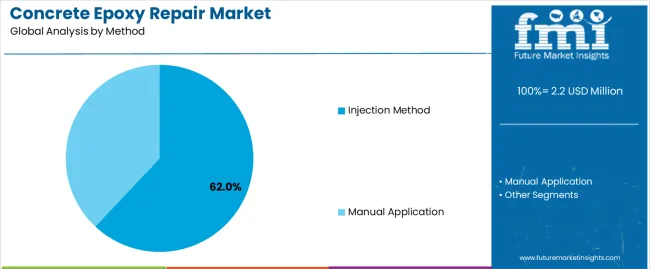
Market Position: Injection Method systems command the leading position in the concrete epoxy repair market with 62% market share through advanced application technologies, including precision delivery systems, consistent material penetration, and construction application optimization that enable repair contractors to achieve optimal performance outcomes across diverse infrastructure and construction environments.
Value Drivers: The segment benefits from construction industry preference for reliable repair systems that provide consistent material delivery, reduced application constraints, and operational efficiency optimization without requiring extensive surface preparation. Advanced injection features enable automated application systems, depth monitoring, and integration with existing construction equipment, where repair precision and material effectiveness represent critical project requirements.
Competitive Advantages: Injection Method systems differentiate through proven application reliability, consistent repair characteristics, and integration with automated construction systems that enhance project effectiveness while maintaining optimal quality standards suitable for diverse infrastructure and construction applications.
Key market characteristics:
Manual Application systems maintain a 38% market position in the concrete epoxy repair market due to their established use and cost-effectiveness advantages. These methods appeal to contractors requiring straightforward repair solutions with proven performance profiles for standard construction applications. Market growth is driven by residential expansion, emphasizing cost-effective repair solutions and operational simplicity through optimized application designs.
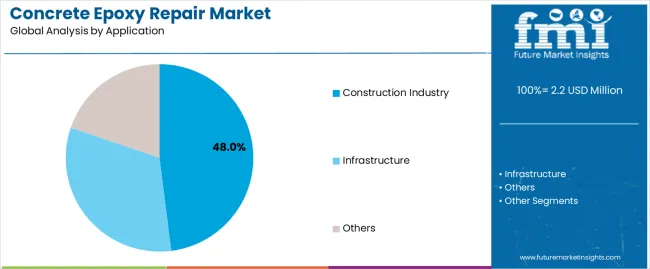
Market Context: Construction industry applications account for a 48% market share in the concrete epoxy repair market, driven by the broad adoption of infrastructure repair systems and a growing focus on construction modernization, operational cost efficiency, and project performance initiatives that enhance material effectiveness while maintaining structural standards. Appeal Factors: Construction operators prioritize material reliability, performance consistency, and integration with existing construction infrastructure that enables coordinated repair operations across multiple project sites. The segment benefits from substantial infrastructure investment and modernization programs that emphasize the acquisition of advanced repair materials for project effectiveness and structural integrity applications.
Growth Drivers: Infrastructure expansion programs incorporate epoxy repair materials as essential components for maintenance projects, while construction growth increases demand for repair capabilities that comply with building standards and minimize project complexity.
Market Challenges: Varying project requirements and construction scale complexity may limit material standardization across different contractors or application scenarios.
Application dynamics include:
Infrastructure applications capture 28% market share through specialized performance requirements in highway maintenance, bridge repair, and transportation infrastructure. These facilities demand high-strength repair materials capable of supporting structural requirements while providing reliable performance access and operational durability capabilities.
Other applications account for 12% market share, including marine structures, underground facilities, and specialized repair requiring advanced material capabilities for environmental optimization and performance effectiveness.
Market Context: Construction Companies dominate the market with 4.6% CAGR, reflecting the primary demand source for concrete epoxy repair technology in infrastructure applications and project operations.
Business Model Advantages: Construction Companies provide direct market demand for advanced repair materials, driving product innovation and capacity expansion while maintaining quality control and project delivery requirements.
Operational Benefits: Construction Company applications include project efficiency, structural integrity, and quality assurance that drive consistent demand for repair materials while providing access to latest material technologies.
| Category | Factor | Impact | Why It Matters |
|---|---|---|---|
| Driver | Infrastructure aging & maintenance demand (bridges, highways, buildings) | ★★★★★ | Growing infrastructure repair market requires materials with exceptional durability and structural integrity proven effective across construction applications. |
| Driver | Construction technology advancement & application efficiency (automated mixing, precision delivery) | ★★★★★ | Turns advanced repair application from "manual" to "automated"; contractors that offer precision application and consistent quality gain competitive advantage. |
| Driver | Industrial facility expansion & maintenance requirements (manufacturing, chemical plants) | ★★★★☆ | Industrial operators need reliable, chemical-resistant repair materials; demand for high-performance repair solutions expanding addressable market. |
| Restraint | Material costs & application complexity (especially for large-scale projects) | ★★★★☆ | Smaller contractors defer adoption; increases cost sensitivity and slows advanced material adoption in price-conscious markets. |
| Restraint | Alternative repair method competition (traditional concrete, mechanical fasteners) | ★★★☆☆ | Conventional repair alternatives offer established procedures and proven performance, potentially limiting epoxy adoption in traditional applications. |
| Trend | Automated application & precision delivery (robotic systems, controlled mixing) | ★★★★★ | Real-time application monitoring, quality tracking, and process analytics transform operations; automation and precision delivery become core value propositions. |
| Trend | Customization & project-specific formulations (infrastructure, industrial, residential) | ★★★★☆ | Custom repair properties for specific applications; specialized materials and targeted performance capabilities drive competition toward customization solutions. |
The concrete epoxy repair market demonstrates varied regional dynamics with Growth Leaders including China (5.8% growth rate) and India (5.4% growth rate) driving expansion through infrastructure development initiatives and construction industry modernization. Steady Performers encompass Germany (4.9% growth rate), Brazil (4.5% growth rate), and developed regions, benefiting from established construction industries and advanced material adoption. Mature Markets feature United States (4.1% growth rate), United Kingdom (3.7% growth rate), and Japan (3.2% growth rate), where infrastructure maintenance and regulatory standardization requirements support consistent growth patterns.
Regional synthesis reveals East Asian markets leading adoption through infrastructure expansion and construction development, while North American countries maintain steady expansion supported by material technology advancement and construction standardization requirements. European markets show strong growth driven by infrastructure applications and modernization integration trends.
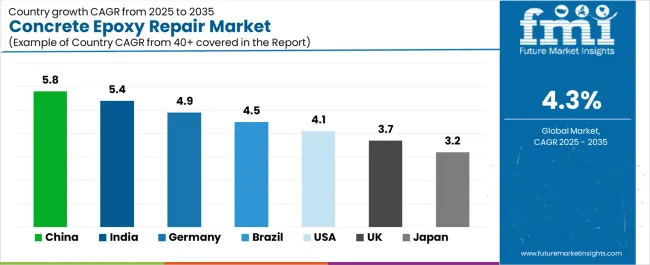
| Region/Country | 2025-2035 Growth | How to win | What to watch out |
|---|---|---|---|
| China | 5.8% | Focus on infrastructure scaling solutions | Regulatory changes; local competition |
| India | 5.4% | Lead with cost-effective construction materials | Import restrictions; technology barriers |
| Germany | 4.9% | Provide premium quality repair materials | Over-regulation; lengthy approvals |
| Brazil | 4.5% | Offer value-oriented construction solutions | Currency fluctuations; import duties |
| United States | 4.1% | Push technology integration | Regulatory compliance costs; scaling challenges |
| United Kingdom | 3.7% | Focus on infrastructure applications | Brexit impacts; material costs |
| Japan | 3.2% | Emphasize precision construction | Traditional preferences; adoption rates |
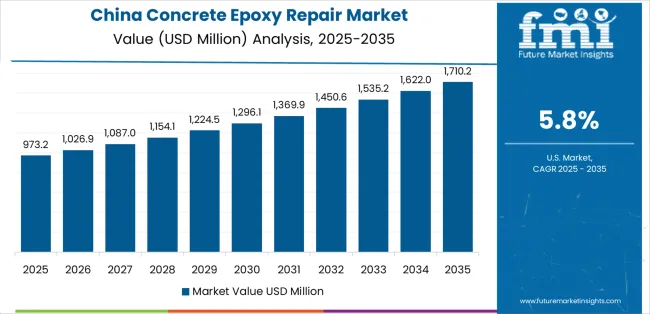
China establishes fastest market growth through aggressive infrastructure development programs and comprehensive construction industry expansion, integrating advanced concrete epoxy repair systems as standard components in infrastructure maintenance facilities and construction installations. The country's 5.8% growth rate reflects government initiatives promoting construction infrastructure and domestic material capabilities that mandate the use of advanced repair systems in construction and infrastructure maintenance facilities. Growth concentrates in major construction hubs, including Beijing, Shanghai, and Guangzhou, where material technology development showcases integrated repair systems that appeal to construction operators seeking advanced material optimization capabilities and infrastructure applications.
Chinese manufacturers are developing cost-effective repair solutions that combine domestic construction advantages with advanced material features, including automated application control and enhanced durability capabilities. Distribution channels through construction equipment suppliers and material distributors expand market access, while government support for infrastructure development supports adoption across diverse construction and maintenance segments.
Strategic Market Indicators:
In Mumbai, Delhi, and Bangalore, construction facilities and infrastructure operators are implementing advanced concrete epoxy repair systems as standard equipment for structural maintenance and project optimization applications, driven by increasing government infrastructure investment and construction modernization programs that emphasize the importance of advanced repair capabilities. The market holds a 5.4% growth rate, supported by government infrastructure initiatives and construction development programs that promote advanced repair systems for construction and infrastructure facilities. Indian operators are adopting repair systems that provide consistent material performance and durability features, particularly appealing in urban regions where structural integrity and material excellence represent critical operational requirements.
Market expansion benefits from growing construction capabilities and international technology partnerships that enable domestic production of advanced repair systems for construction and infrastructure applications. Technology adoption follows patterns established in construction equipment, where reliability and performance drive procurement decisions and operational deployment.
Market Intelligence Brief:
Germany's advanced construction market demonstrates sophisticated concrete epoxy repair deployment with documented material effectiveness in infrastructure applications and construction facilities through integration with existing construction systems and maintenance infrastructure. The country leverages engineering expertise in construction and quality systems integration to maintain a 4.9% growth rate. Construction centers, including Bavaria, Baden-Württemberg, and North Rhine-Westphalia, showcase premium installations where repair systems integrate with comprehensive construction platforms and facility management systems to optimize maintenance operations and structural effectiveness.
German manufacturers prioritize system precision and EU compliance in repair equipment development, creating demand for premium systems with advanced features, including facility monitoring integration and automated quality systems. The market benefits from established construction infrastructure and a willingness to invest in advanced repair technologies that provide long-term operational benefits and compliance with international construction standards.
Market Intelligence Brief:
Brazil's market expansion benefits from diverse construction demand, including infrastructure modernization in São Paulo and Rio de Janeiro, construction facility upgrades, and government infrastructure programs that increasingly incorporate advanced repair solutions for construction applications. The country maintains a 4.5% growth rate, driven by rising construction activity and increasing recognition of repair technology benefits, including precise structural control and enhanced construction effectiveness.
Market dynamics focus on cost-effective repair solutions that balance advanced construction performance with affordability considerations important to Brazilian construction operators. Growing infrastructure development creates continued demand for modern repair systems in new facility infrastructure and construction modernization projects.
Strategic Market Considerations:
United States establishes market leadership through comprehensive infrastructure programs and advanced construction infrastructure development, integrating concrete epoxy repair systems across construction and maintenance applications. The country's 4.1% growth rate reflects established construction industry relationships and mature repair technology adoption that supports widespread use of precision repair systems in construction and infrastructure facilities. Growth concentrates in major construction centers, including Texas, California, and Florida, where repair technology showcases mature construction deployment that appeals to construction operators seeking proven repair capabilities and operational efficiency applications.
American construction providers leverage established distribution networks and comprehensive technical support capabilities, including validation programs and training support that create customer relationships and operational advantages. The market benefits from mature regulatory standards and construction requirements that mandate repair system use while supporting technology advancement and operational optimization.
Market Intelligence Brief:
United Kingdom's construction market demonstrates integrated concrete epoxy repair deployment with documented structural effectiveness in infrastructure applications and construction facilities through integration with existing construction systems and maintenance infrastructure. The country maintains a 3.7% growth rate, supported by infrastructure innovation programs and construction effectiveness requirements that promote advanced repair systems for infrastructure applications. Construction facilities across England, Scotland, and Wales showcase systematic installations where repair systems integrate with comprehensive construction platforms to optimize maintenance operations and structural outcomes.
UK construction providers prioritize system reliability and infrastructure compatibility in repair equipment procurement, creating demand for validated systems with proven construction features, including quality monitoring integration and automated construction systems. The market benefits from established construction infrastructure and innovation requirements that support repair technology adoption and operational effectiveness.
Market Intelligence Brief:
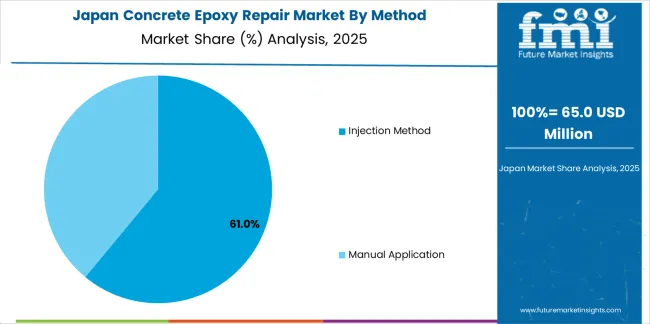
Japan's market growth benefits from precision construction demand, including advanced infrastructure facilities in Tokyo and Osaka, construction integration, and quality enhancement programs that increasingly incorporate repair solutions for construction applications. The country maintains a 3.2% growth rate, driven by construction technology advancement and increasing recognition of precision repair benefits, including accurate structural control and enhanced construction outcomes.
Market dynamics focus on high-precision repair solutions that meet Japanese quality standards and construction effectiveness requirements important to construction operators. Advanced construction technology adoption creates continued demand for sophisticated repair systems in infrastructure facility infrastructure and construction modernization projects.
Strategic Market Considerations:
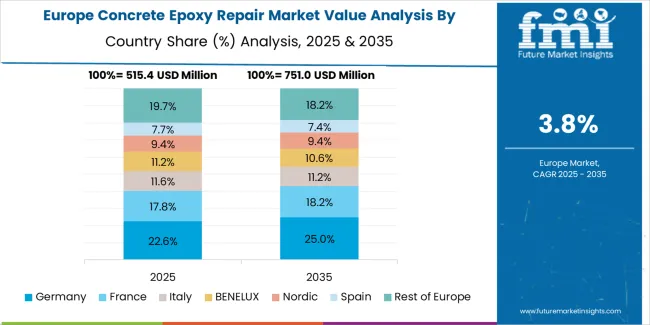
The European concrete epoxy repair market is projected to grow from USD 589.2 million in 2025 to USD 865.4 million by 2035, registering a CAGR of 3.9% over the forecast period. Germany is expected to maintain its leadership position with a 38.7% market share in 2025, supported by its advanced construction infrastructure and major industrial centers.
United Kingdom follows with a 24.1% share in 2025, driven by comprehensive infrastructure programs and construction modernization development initiatives. France holds a 16.8% share through specialized construction applications and regulatory compliance requirements. Italy commands a 12.3% share, while Spain accounts for 8.1% in 2025. The rest of Europe region is anticipated to gain momentum, expanding its collective share from 4.2% to 4.8% by 2035, attributed to increasing construction adoption in Nordic countries and emerging infrastructure facilities implementing construction modernization programs.
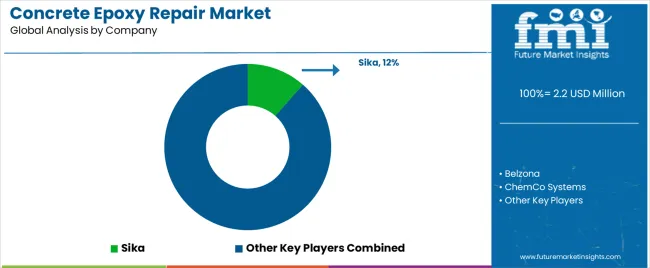
| Stakeholder | What they actually control | Typical strengths | Typical blind spots |
|---|---|---|---|
| Global platforms | Distribution reach, broad product catalogs, technical support networks | Wide availability, proven technology, multi-region support | Product refresh cycles; customer dependency on technical validation |
| Construction innovators | R&D capabilities; advanced repair technologies; enhanced material properties | Latest technologies first; attractive ROI on construction effectiveness | Service density outside core regions; scaling complexity |
| Regional specialists | Local compliance, fast delivery, nearby technical support | "Close to site" support; pragmatic pricing; local regulations | Technology gaps; talent retention in technical support |
| Application-focused ecosystems | Material validation, application development, regulatory support | Lowest technical risk; comprehensive support | Service costs if overpromised; technology obsolescence |
| Niche specialists | Specialized applications, custom materials, research support | Win research/development applications; flexible configurations | Scalability limitations; narrow market focus |
| Item | Value |
|---|---|
| Quantitative Units | USD 2.2 million |
| Method | Manual Application, Injection Method |
| Application | Construction Industry, Infrastructure, Others |
| End Use | Construction Companies, Infrastructure Operators, Industrial Facilities, Residential Contractors, Maintenance Services |
| Regions Covered | North America, Latin America, Western Europe, Eastern Europe, East Asia, South Asia Pacific, Middle East & Africa |
| Countries Covered | China, India, Germany, Brazil, United States, United Kingdom, Japan, Canada, France, Australia, and 25+ additional countries |
| Key Companies Profiled | Sika AG, Belzona International Ltd., ChemCo Systems, Abatron, Inc., Simpson Strong-Tie Company Inc., Adhesives Technology Corporation, Watco Floors, R.C. Davis Company, Inc., Metzger McGuire, and Delta Polymers, Inc. |
| Additional Attributes | Dollar sales by method and application categories, regional adoption trends across East Asia, North America, and Western Europe, competitive landscape with construction manufacturers and repair suppliers, construction operator preferences for material effectiveness and application reliability, integration with construction platforms and quality monitoring systems, innovations in repair application and material enhancement, and development of advanced construction solutions with enhanced performance and infrastructure optimization capabilities. |
The global concrete epoxy repair market is estimated to be valued at USD 2.2 million in 2025.
The market size for the concrete epoxy repair market is projected to reach USD 3.3 million by 2035.
The concrete epoxy repair market is expected to grow at a 4.3% CAGR between 2025 and 2035.
The key product types in concrete epoxy repair market are injection method and manual application.
In terms of application, construction industry segment to command 48.0% share in the concrete epoxy repair market in 2025.






Our Research Products

The "Full Research Suite" delivers actionable market intel, deep dives on markets or technologies, so clients act faster, cut risk, and unlock growth.

The Leaderboard benchmarks and ranks top vendors, classifying them as Established Leaders, Leading Challengers, or Disruptors & Challengers.

Locates where complements amplify value and substitutes erode it, forecasting net impact by horizon

We deliver granular, decision-grade intel: market sizing, 5-year forecasts, pricing, adoption, usage, revenue, and operational KPIs—plus competitor tracking, regulation, and value chains—across 60 countries broadly.

Spot the shifts before they hit your P&L. We track inflection points, adoption curves, pricing moves, and ecosystem plays to show where demand is heading, why it is changing, and what to do next across high-growth markets and disruptive tech

Real-time reads of user behavior. We track shifting priorities, perceptions of today’s and next-gen services, and provider experience, then pace how fast tech moves from trial to adoption, blending buyer, consumer, and channel inputs with social signals (#WhySwitch, #UX).

Partner with our analyst team to build a custom report designed around your business priorities. From analysing market trends to assessing competitors or crafting bespoke datasets, we tailor insights to your needs.
Supplier Intelligence
Discovery & Profiling
Capacity & Footprint
Performance & Risk
Compliance & Governance
Commercial Readiness
Who Supplies Whom
Scorecards & Shortlists
Playbooks & Docs
Category Intelligence
Definition & Scope
Demand & Use Cases
Cost Drivers
Market Structure
Supply Chain Map
Trade & Policy
Operating Norms
Deliverables
Buyer Intelligence
Account Basics
Spend & Scope
Procurement Model
Vendor Requirements
Terms & Policies
Entry Strategy
Pain Points & Triggers
Outputs
Pricing Analysis
Benchmarks
Trends
Should-Cost
Indexation
Landed Cost
Commercial Terms
Deliverables
Brand Analysis
Positioning & Value Prop
Share & Presence
Customer Evidence
Go-to-Market
Digital & Reputation
Compliance & Trust
KPIs & Gaps
Outputs
Full Research Suite comprises of:
Market outlook & trends analysis
Interviews & case studies
Strategic recommendations
Vendor profiles & capabilities analysis
5-year forecasts
8 regions and 60+ country-level data splits
Market segment data splits
12 months of continuous data updates
DELIVERED AS:
PDF EXCEL ONLINE
Epoxy Casting Potting Resin Market Size and Share Forecast Outlook 2025 to 2035
Epoxy Resin Industry Analysis in Asia Pacific Size and Share Forecast Outlook 2025 to 2035
Epoxy Type Stabilizers Market Size and Share Forecast Outlook 2025 to 2035
Concrete Fiber Market Size and Share Forecast Outlook 2025 to 2035
Epoxy Grouts Market Size and Share Forecast Outlook 2025 to 2035
Concrete Densification and Polishing Material Market Size and Share Forecast Outlook 2025 to 2035
Concrete Surface Retarders Market Size and Share Forecast Outlook 2025 to 2035
Concrete Densifier Market Size and Share Forecast Outlook 2025 to 2035
Concrete Containing Polymer Market Size and Share Forecast Outlook 2025 to 2035
Epoxy Putty and Construction Chemicals Market Size and Share Forecast Outlook 2025 to 2035
Concrete Bonding Agents Market Size and Share Forecast Outlook 2025 to 2035
Concrete Block Making Machines Market Size and Share Forecast Outlook 2025 to 2035
Concrete Air Entraining Agents Market Size and Share Forecast Outlook 2025 to 2035
Epoxy Active Diluent Market Size and Share Forecast Outlook 2025 to 2035
Epoxy Composite Market Size and Share Forecast Outlook 2025 to 2035
Concrete Placing Booms Market Size and Share Forecast Outlook 2025 to 2035
Concrete Accelerators And Retarders Market Size and Share Forecast Outlook 2025 to 2035
Concrete Chain Saw Market Size and Share Forecast Outlook 2025 to 2035
Concrete Surface Treatment Chemicals Market Size and Share Forecast Outlook 2025 to 2035
Concrete Paving Equipment Market Size and Share Forecast Outlook 2025 to 2035

Thank you!
You will receive an email from our Business Development Manager. Please be sure to check your SPAM/JUNK folder too.
Chat With
MaRIA